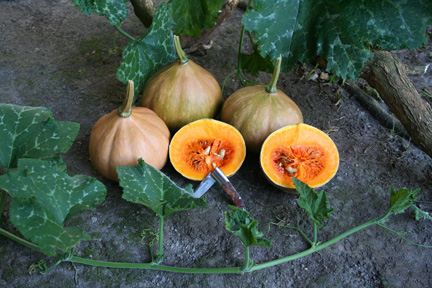Summer Garden

As published in the Miami Herald
By Richard J. Campbell
THE SEMINOLE PUMPKIN

The windows are all shut now; the air-conditioner doing its job again. The Spring time has arrived in South Florida. So, what is on tap for the home vegetable garden? One can go inside and vegetate for the entire summer season, or one can evolve and thrive. It is time to break out those unique South Florida vegetables and sit back and watch them flourish among the heat and humidity of the South Florida monsoon.
There is still time to plant larger herb plants into containers and make your kitchen garden. By growing your herbs in containers, with a well drained potted mix and daily watering, one can grow right into the summer. The rosemary and lavender, chives and parsley will do well in the heat of the late spring. As the summer monsoon comes they must be maintained with ample air movement and space between pots to avoid succumbing to fungal diseases. However, with a little luck one can maintain your herbs straight through the summer and into the Fall.
Near and dear to my heart is the Seminole pumpkin. This is a vigorous vine native to the Everglades that can provide a nutritious and delicious vegetable throughout the summer. In the case of the Seminole pumpkin, the summer is the only time that it grows at its best. The vines are best started from seed after the cool nights have given way to our prevailing easterly winds. This usually occurs in mid-April and signals the beginning of Seminole pumpkin planting season. This vegetable can be grown throughout the summer.
For success one must provide the vigorous vine with a tree or trellis to grow upon. It will quickly take advantage of the structure that you have provided, rambling high above your head and producing numerous male and a few female flowers. For best results one should pollinate the female flowers using the males on the same vine. It is easy and takes very little time. Hand pollination with produce more and large fruit on your vines. The pumpkins begin to set and will soon be hanging high over head. As we enter the Fall the vines will die away, leaving the burnt-orange pumpkins hanging above.
The Seminole pumpkin serves well for anyone who prizes the calabaza and winter squash in general. It stores without refrigeration for months on end and can find its place on your table every day, in soups, sauces and stir-fries. Its past is storied as well, providing food for the Seminole and Miccosukee alike for hundreds of years. In fact it was the Seminole pumpkin that may have started one of the Seminole-American wars of Florida’s past. Legend has it that United States soldiers provoked conflict deep in the Florida Everglades by shooting Seminole pumpkins from the trees. As any gardener knows, the shooting of one’s pumpkins is a clear declaration of war.
A good companion to the Seminole pumpkin is the luffa sponge. Also a vine, the luffa grows well in the late Spring and summer and sets large gourds that can be dried and used for many artisanal projects. The vine is highly vigorous and a strong trellis or fence must be used to support the weight of the vines.
Hot peppers of all manner of shapes and sizes will serve both in a raised bed and also in containers. Habaneros and cayenne peppers are two particular stars of our late Spring and summer, but many others will work, including ornamental types.
Summer garden specialties can be ordered through catalogs and also found in local garden centers and even grocery stores. For Seminole pumpkin seed one should attend local vegetable gardening events and club meetings. There is still considerable seed sharing that goes on behind the scenes within gardening circles and on the internet as well. Good growing.
